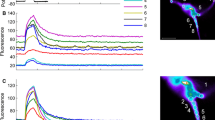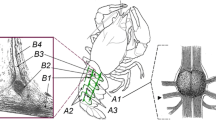Summary
-
1.
Aconitine in the range of 10−5 g/ml induces depolarization and discharge of action potentials in the receptor neurone of the slowly adapting stretch receptor of the crayfishAstacus astacus L.
-
2.
The action of aconitine is reversible by repeated washing of the receptor.
-
3.
The generator potential due to stretch of the receptor muscle is unaffected by aconitine within the range of concentrations investigated (up to 10−4 g/ml).
-
4.
If the regenerative membrane elements of the receptor neurone are blocked with tetrodotoxin or if the sodium ions are removed from the Harreveldt-solution, the resting potential remains unaffected even by very high concentrations (10−3 g/ml) of aconitine. The membrane resistance of neurones pretreated with tetrodotoxin remains unaffected by additional application of aconitine.
-
5.
It is concluded that the action of aconitine in the slowly adapting stretch receptor neurone of the crayfish is due to an increase in the sodium permeability of its regenerative membrane elements.
-
6.
It is suggested that the mechanisms controlling other types of ionic permeabilities remain unaffected.
-
7.
As a side result, in confirmation of previous authors the generator potential was found to be unaffected by tetrodotoxin.
-
8.
The results are in support of the hypothesis ofPaintal on the mode of action of chemical substances on mechanoreceptors.
Similar content being viewed by others
References
Albuquerque, E. X., andW. Grampp: Effects of tetrodotoxin on the slowly adapting stretch receptor neurone of the lobster. J. Physiol. (Lond.)195, 141–156 (1968).
Burkhardt, D.: Die Erregungsvorgänge sensibler Ganglienzellen in Abhängigkeit von der Temperatur. Biol. Zbl.78, 22–62 (1959).
Dudel, J.: Presynaptic inhibition of the excitatory nerve terminal in the neuromuscular junction of the crayfish. Pflügers Arch. ges. Physiol.277, 537–557 (1963).
Edwards, C., andD. Ottoson: The site of impulse initiation in a nerve cell of a crustacean stretch receptor. J. Physiol. (Lond.)143, 138–148 (1958).
—,C. A. Terzuolo, andY. Washizu: The effect of changes of the ionic environment upon an isolated crustacean sensory neurone. J. Neurophysiol26, 948–957 (1963).
Eyzaguirre, C., andS. W. Kuffler: Process of excitation in the dendrites and in the soma of single isolated sensory nerve cells of the lobster and crayfish. J. gen. Physiol.39, 87–119 (1955).
Harreveldt, A. van: A physiological solution for freshwater crustaceans. Proc. Soc. exp. Biol. (N.Y.)34, 428–432 (1936).
Herzog, W. H., R. M. Feibel, andS. H. Bryant: The effect of aconitine on the giant axon of the squid. J. gen. Physiol.47, 719–733 (1964).
Loewenstein, W. R., C. A. Terzuolo, andY. Washizu: Separation of transducer and impulse-generating processes in sensory receptors. Science142, 1180–1181 (1963).
Nishi, K., andM. Sato: Blocking the impulse and depression of the receptor potential by tetrodotoxin in non-myelinated nerve terminals in Pacinian corpuscles. J. Physiol. (Lond.)184, 376–386 (1966).
Paintal, A. S.: Effects of drugs on vertebrate mechanoreceptors. Pharmacol. Rev.16, 341–380 (1964).
Peper, K., andW. Trautwein: The effect of aconitine on the membrane current in cardiac muscle. Pflügers Arch. ges. Physiol.296, 328–336 (1967).
Terzuolo, C. A., andY. Washizu: Relation between stimulus strength, generator potential and impulse frequency in stretch receptor of crustacea. J. Neurophysiol.25, 56–66 (1962).
Washizu, Y., andC. A. Terzuolo: Impulse activity in the crayfish stretch receptor neurone. Arch. ital. Biol.104, 181–194 (1966).
Wellhöner, H. H., u.B. Conrad: Über die Wirkung von Aconitin auf die Impulstätigkeit in afferenten Fasern aus Lungendehnungsreceptoren. Naunyn-Schmiedebergs Arch. exp. Path. Pharmak.252, 269–285 (1965).
—, u.D. Haferkorn: Die Wirkung von Aconitin auf die Impulsbildung durch Mechanoreceptoren des Sinus caroticus und des Herzens. Naunyn-Schmiedebergs Arch. Pharmak. exp. Path.255, 407–418 (1966).
Wiersma, C. A. G., E. Furshpan, andE. Florey: Physiological and pharmacological observations on muscle receptor organs of the crayfish,Cambarus Clarkii Girard. J. exp. Biol.30, 136–150 (1953).
Author information
Authors and Affiliations
Additional information
A preliminary communication has been given at the 1967 Spring Meeting of the Deutsche Pharmakologische Gesellschaft [Naunyn-Schmiedebergs Arch. Pharmak. exp. Path.257, 350 (1967)].
Rights and permissions
About this article
Cite this article
Wellhöner, HH. Effects of aconitine on the slowly adapting stretch receptor neurone of the crayfish. Pflugers Arch. 304, 104–117 (1968). https://doi.org/10.1007/BF00586723
Received:
Issue Date:
DOI: https://doi.org/10.1007/BF00586723




